- 08 JUILLET
- INDI-UNI : 
PRE-INSCRIPTION : 15 Juin – 15 Août
PRE-REGISTRATION: June 15th - August 15th
- SUISSE – 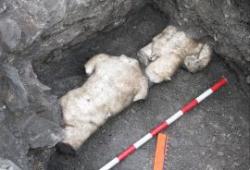 Martigny - Une découverte archéologique majeure a été faite mercredi sur le chantier de la route des Morasses, au centre-ville de Martigny. Deux statues en marbre, représentant le torse de jeunes hommes, ont été mises au jour par l'archéologue cantonal, François Wiblé. Deux torses de jeunes éphèbes en marbre, dans un bel état. «C’est probablement du marbre de Carrare. Les œuvres sont d’excellente facture, vraisemblablement des reproductions de statues grecques. Je pense qu’elles datent du Haut Empire romain, du 1er ou du 2e siècle, mais il faudra affiner les recherches.» Elles se trouvent dans ce qui devait être la demeure d’un homme important, dotées de thermes et situées à proximité immédiate du forum. Les deux statues étaient posées près d’un des murs de l’édifice. Après les grands bronzes découverts en 1883 et la Vénus d’Octodure en 1939, il s’agit de la plus importante trouvaille d’objets d’art sur le site octodurien. La zone, située au centre-ville de Martigny, est en effet très riche en vestiges romains. A deux pas du site mis au jour mercredi, les sous-sols de la villa Minerva - un immeuble résidentiel – abritent d’ailleurs la vaste demeure d’un notable. D’autres murs et vestiges ont également été découverts. Ils ont été systématiquement relevés, dessinés, mesurés. Les archéologues décideront par la suite s’il convient d’étendre leurs fouilles pour tenter de trouver d’autres objets.
Martigny - Une découverte archéologique majeure a été faite mercredi sur le chantier de la route des Morasses, au centre-ville de Martigny. Deux statues en marbre, représentant le torse de jeunes hommes, ont été mises au jour par l'archéologue cantonal, François Wiblé. Deux torses de jeunes éphèbes en marbre, dans un bel état. «C’est probablement du marbre de Carrare. Les œuvres sont d’excellente facture, vraisemblablement des reproductions de statues grecques. Je pense qu’elles datent du Haut Empire romain, du 1er ou du 2e siècle, mais il faudra affiner les recherches.» Elles se trouvent dans ce qui devait être la demeure d’un homme important, dotées de thermes et situées à proximité immédiate du forum. Les deux statues étaient posées près d’un des murs de l’édifice. Après les grands bronzes découverts en 1883 et la Vénus d’Octodure en 1939, il s’agit de la plus importante trouvaille d’objets d’art sur le site octodurien. La zone, située au centre-ville de Martigny, est en effet très riche en vestiges romains. A deux pas du site mis au jour mercredi, les sous-sols de la villa Minerva - un immeuble résidentiel – abritent d’ailleurs la vaste demeure d’un notable. D’autres murs et vestiges ont également été découverts. Ils ont été systématiquement relevés, dessinés, mesurés. Les archéologues décideront par la suite s’il convient d’étendre leurs fouilles pour tenter de trouver d’autres objets.
http://www.lenouvelliste.ch/fr/news/flash_info/deux-statues-romaines-decouvertes-aux-morasses-0-301680
- FRANCE – 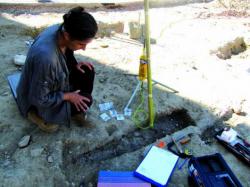 Caen - Des fouilles archéologiques ont débuté en mai sur la place Saint-Sauveur. Une place du marché depuis le XIIIe siècle… Autour de la statue de Louis XIV, « nous avons notamment découvert des ornières qui attestent du passage de chariots », raconte Bénédicte Guillot, chargée d’études et d’opération à l’INRAP, l’Institut national de recherches archéologiques préventives. Cependant, « aucun étal maçonné », du marché datant du XIIIe au XVe siècle n’a été trouvé, « ce qui laisse à penser qu’ils étaient de facture légère, sans doute en bois, et facilement transportables, estime l’archéologue. Des ossements d’animaux, des fragments de céramique, des billes de terre cuite et des fers, appartenant aux animaux qui traversaient la place » ont également été mis à jour. Tous ces vestiges confirment bien de l’existence d’un marché sur la place, à cette époque. … Et un cimetière d’enfants. Sous le parvis de l’église du Vieux Saint- Sauveur, lors d’un précédent diagnostic, les archéologues avaient également découvert un cimetière d’enfants. Pour le moment une quinzaine de tombes datant des XVIe et XVIIe siècles ont ainsi été minutieusement fouillées. « Elles sont toujours bien conservées. Ce sont des enfants en bas âge, de moins de trois ans ». Des restes de bois des cercueils ainsi que des morceaux de tissu, en guise de linceul, ont été identifiés. « Nous avons aussi trouvé des épingles en bronze utilisées pour fixer le linceul », poursuit Bénédicte Guillot. Une étude des sépultures, avec l’anthropologue Aminte Thoman, devrait permettre notamment de déterminer la cause du décès de ces enfants. Une première étude biologique montre « qu’ils souffraient de maladies liées à des carences alimentaires graves », remarque l’archéologue ce qui « a entraîné leur mort ». Cette troisième phase devrait clôturer le chantier. Sa fermeture est programmée pour le 29 juillet.
Caen - Des fouilles archéologiques ont débuté en mai sur la place Saint-Sauveur. Une place du marché depuis le XIIIe siècle… Autour de la statue de Louis XIV, « nous avons notamment découvert des ornières qui attestent du passage de chariots », raconte Bénédicte Guillot, chargée d’études et d’opération à l’INRAP, l’Institut national de recherches archéologiques préventives. Cependant, « aucun étal maçonné », du marché datant du XIIIe au XVe siècle n’a été trouvé, « ce qui laisse à penser qu’ils étaient de facture légère, sans doute en bois, et facilement transportables, estime l’archéologue. Des ossements d’animaux, des fragments de céramique, des billes de terre cuite et des fers, appartenant aux animaux qui traversaient la place » ont également été mis à jour. Tous ces vestiges confirment bien de l’existence d’un marché sur la place, à cette époque. … Et un cimetière d’enfants. Sous le parvis de l’église du Vieux Saint- Sauveur, lors d’un précédent diagnostic, les archéologues avaient également découvert un cimetière d’enfants. Pour le moment une quinzaine de tombes datant des XVIe et XVIIe siècles ont ainsi été minutieusement fouillées. « Elles sont toujours bien conservées. Ce sont des enfants en bas âge, de moins de trois ans ». Des restes de bois des cercueils ainsi que des morceaux de tissu, en guise de linceul, ont été identifiés. « Nous avons aussi trouvé des épingles en bronze utilisées pour fixer le linceul », poursuit Bénédicte Guillot. Une étude des sépultures, avec l’anthropologue Aminte Thoman, devrait permettre notamment de déterminer la cause du décès de ces enfants. Une première étude biologique montre « qu’ils souffraient de maladies liées à des carences alimentaires graves », remarque l’archéologue ce qui « a entraîné leur mort ». Cette troisième phase devrait clôturer le chantier. Sa fermeture est programmée pour le 29 juillet.
http://www.cotecaen.fr/2011/07/07/a-caen-remontez-le-temps-place-saint-sauveur-ce-samedi/
- SERBIE – Viminacium - Serbia is currently excavating the archaeological ruins of the major Roman city and military camp of Moesia (now Serbia) dating back to the First century AD. Already attracting in excess of 60,000 visitors a year, Viminacium located 90 miles south-east of Belgrade is already making its mark with tourists. Covering an expanse of over 450 hectares, the site contains the remains of temples, streets, squares, amphitheatres, palaces, hippodromes and Roman baths and lies on the Roman Road, via Milatris. Having excavated only 2 per cent of the city and military camp, archaeologists have already unearthed roman baths which clearly demonstrate the advance thinking of the Romans with ancient under floor heating and flushing toilets. The Mausoleum has already various graves and visitors can explore under tunnel 4th Century frescoes which have already been revealed. The amphitheatre, which can hold up to 12,000 people and is one of the largest to be found in the Balkans and is still undergoing excavation work, but there is already plenty to see. Next year, in conjunction with the Rome opera House there will be a production of Aida – the first in a series of concerts planned for the Viminacium amphitheatre. Two years ago, Viminacium discovered a mamouth skeleton dating back some 5 million years and this should be on public view soon. Viminacium has also recently built a new science and research visitor centre, complete with a library and a restaurant which will, when it opens later this year, serve Roman inspired dishes. There is also a new 15 room hotel for visitors wishing to explore the site for more than a fleeting tour, and accommodation is also being built for archaeology students or visitors who are interested in working with one of the excavation teams on site.
http://www.easier.com/92001-serbia-unearths-major-tourist-attraction.html
- ROYAUME UNI – 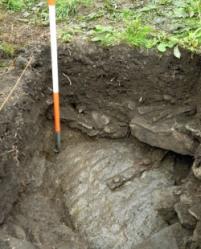 Thrumster - A mystery find at the site of a Caithness broch has experts stumped. It’s less than a week into the Yarrows Heritage Trust’s fact-finding mission at Thrumster and a strange feature has been unearthed. This latest excavation – supervised by AOC Archaeology – started on Monday and runs until July 24. It aims to reveal information about the stone dwelling as well as find out more about a 19th-century excavation when the roundhouse was emptied of rubble and a summer house built in the entrance. Chairman of AOC Archaeology and director of the excavations John Barber explained the "landscape gardening" episode in the 19th-century period refashioned the broch, as well as removing a quarter of the dwelling wall which was replaced with a stone-built summer house. "Although not the primary focus of the current research, exploration of this early exercise in landscape gardening has revealed a mysterious feature – a large iron strap solidly riveted into what is either bedrock or a very large stone slab," said Mr Barber. "Suggestions as to the use or function of this interesting piece of ironmongery will be gratefully received." The iron strap is around 8cm wide, a metre long and is curled at one end. It is riveted to the ground and runs through the centre of the broch to either side where the two quadrants have been dug up.
Thrumster - A mystery find at the site of a Caithness broch has experts stumped. It’s less than a week into the Yarrows Heritage Trust’s fact-finding mission at Thrumster and a strange feature has been unearthed. This latest excavation – supervised by AOC Archaeology – started on Monday and runs until July 24. It aims to reveal information about the stone dwelling as well as find out more about a 19th-century excavation when the roundhouse was emptied of rubble and a summer house built in the entrance. Chairman of AOC Archaeology and director of the excavations John Barber explained the "landscape gardening" episode in the 19th-century period refashioned the broch, as well as removing a quarter of the dwelling wall which was replaced with a stone-built summer house. "Although not the primary focus of the current research, exploration of this early exercise in landscape gardening has revealed a mysterious feature – a large iron strap solidly riveted into what is either bedrock or a very large stone slab," said Mr Barber. "Suggestions as to the use or function of this interesting piece of ironmongery will be gratefully received." The iron strap is around 8cm wide, a metre long and is curled at one end. It is riveted to the ground and runs through the centre of the broch to either side where the two quadrants have been dug up.
http://www.johnogroat-journal.co.uk/News/Mystery-Thrumster-broch-find-has-experts-guessing-07072011.htm
- USA – Dearfield - The stories of Dearfield and Meeker House are likely familiar to readers of this column. Dearfield is the black colony founded and championed by O.T. Jackson that had 300 residents at its height and came alive on weekends with social gatherings centered on music, dancing and hunting that attracted blacks from as far away as Denver. Meeker House was the 1870 home of Greeley’s founder Nathan Meeker. Both sites have rich histories, but histories that leave many questions unanswered, and this summer archaeologists will begin investigations into those respective mysteries.
http://www.greeleytribune.com/article/20110707/NEWS/707079951/1002&parentprofile=1001
- PHILIPPINES – 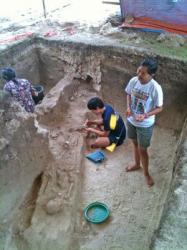
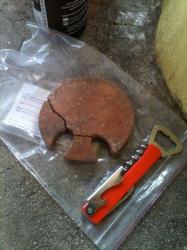 Ceibu - An archaeological dig in the Philippines for students of the University of Guam has uncovered a treasure trove of Iron Age artifacts that date back to more than a thousand years ago. “Burials, pots and other artifacts were uncovered that date back to the Iron Age, which spans the centuries from a thousand to 1,500 years ago,” said John Peterson, director of UOG's Micronesian Area Research Center. “Also discovered is what we believe to be a ceramic lingling-o pendant, which is a fertility symbol.” Cebu was the first seat of the Spanish colonial government in the Philippines and the field school aimed, in part, to document the impact of Spanish colonization on indigenous life-ways in the shadow of the parish church in San Remigio.
Ceibu - An archaeological dig in the Philippines for students of the University of Guam has uncovered a treasure trove of Iron Age artifacts that date back to more than a thousand years ago. “Burials, pots and other artifacts were uncovered that date back to the Iron Age, which spans the centuries from a thousand to 1,500 years ago,” said John Peterson, director of UOG's Micronesian Area Research Center. “Also discovered is what we believe to be a ceramic lingling-o pendant, which is a fertility symbol.” Cebu was the first seat of the Spanish colonial government in the Philippines and the field school aimed, in part, to document the impact of Spanish colonization on indigenous life-ways in the shadow of the parish church in San Remigio.
http://www.saipantribune.com/newsstory.aspx?cat=21&newsID=110923
- ITALIE – 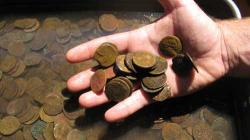 Pantelleria - Découverte d'un trésor monétaire d'environ 600 pièces puniques en bronze du IIIe av JC.
Pantelleria - Découverte d'un trésor monétaire d'environ 600 pièces puniques en bronze du IIIe av JC.
http://www.beniculturali.it/mibac/export/MiBAC/sito-MiBAC/Contenuti/MibacUnif/Comunicati/visualizza_asset.html_817688320.html
- ESPAGNE –  Compostelle - Le Códice calixtino, un manuscrit du XIIe siècle d'une valeur inestimable, considéré comme le premier "guide" du chemin de Compostelle, a mystérieusement disparu de la cathédrale de Saint-Jacques, haut-lieu de pèlerinage dans le nord-ouest de l'Espagne. Le précieux volume, attribué au pape Calixte II, était habituellement entreposé dans une salle de la cathédrale à laquelle n'ont accès qu'une demi-douzaine de personnes. Joyau du patrimoine culturel de l'Espagne, ce livre renferme des textes relatifs au culte de saint Jacques et au chemin de pèlerinage menant à la tombe de l'apôtre. Il est en principe conservé à l'abri des regards et n'est présenté au public qu'en de très rares occasions. Le pape Calixte II a contribué au Moyen Age à l'essor du chemin de Saint-Jacques. Il avait décidé en 1122 que chaque année où la fête de l'apôtre, le 25 juillet, tomberait un dimanche serait décrétée "année sainte". 2010 a été la dernière année sainte et la prochaine sera 2021.
Compostelle - Le Códice calixtino, un manuscrit du XIIe siècle d'une valeur inestimable, considéré comme le premier "guide" du chemin de Compostelle, a mystérieusement disparu de la cathédrale de Saint-Jacques, haut-lieu de pèlerinage dans le nord-ouest de l'Espagne. Le précieux volume, attribué au pape Calixte II, était habituellement entreposé dans une salle de la cathédrale à laquelle n'ont accès qu'une demi-douzaine de personnes. Joyau du patrimoine culturel de l'Espagne, ce livre renferme des textes relatifs au culte de saint Jacques et au chemin de pèlerinage menant à la tombe de l'apôtre. Il est en principe conservé à l'abri des regards et n'est présenté au public qu'en de très rares occasions. Le pape Calixte II a contribué au Moyen Age à l'essor du chemin de Saint-Jacques. Il avait décidé en 1122 que chaque année où la fête de l'apôtre, le 25 juillet, tomberait un dimanche serait décrétée "année sainte". 2010 a été la dernière année sainte et la prochaine sera 2021.
http://www.lemonde.fr/culture/article/2011/07/07/compostelle-mysterieuse-disparition-d-un-precieux-manuscrit_1545858_3246.html#xtor=RSS-3208